Dieffenbach's rail
Dieffenbach's rail (Hypotaenidia dieffenbachii) is an extinct flightless species of bird from the family Rallidae. It was endemic to the Chatham Islands and referred to as meriki, or mehoriki, by the indigenous Moriori. The only recorded living specimen of Dieffenbach's rail was captured in 1840 by Ernst Dieffenbach, who is commemorated in the scientific and common name of the species. It became extinct due to hunting and introduced predators, perhaps soon after 1840.
| Dieffenbach's rail | |
|---|---|
.png.webp) | |
| Scientific classification | |
| Kingdom: | Animalia |
| Phylum: | Chordata |
| Class: | Aves |
| Order: | Gruiformes |
| Family: | Rallidae |
| Genus: | Hypotaenidia |
| Species: | H. dieffenbachii |
| Binomial name | |
| Hypotaenidia dieffenbachii (Gray, 1843) | |
| Synonyms | |
|
Hypotaenidia dieffenbachii (Gray, 1843) | |
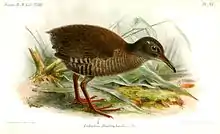

The Dieffenbach's rail was sympatric with the flightless Chatham rail. Their sympatry suggests parallel evolution after separate colonisation of the Chatham Islands by a common volant ancestor, presumably the buff-banded rail (Hypotaenidia philippensis).[2] A 2014 genetic analysis found that the taxa were not particularly closely related, with Dieffenbach's rail being sister to the group of Hypotaenidia including the Buff-banded rail, while the Chatham rail was found to be in a more basal position.[3]
- Various views of the skull of Dieffenbach's rail
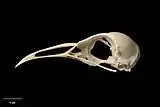 Lateral view
Lateral view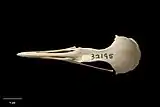 Dorsal view
Dorsal view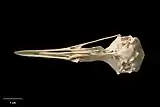 Ventral view
Ventral view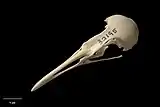 Oblique view
Oblique view
References
- BirdLife International (2016). "Hypotaenidia dieffenbachii". IUCN Red List of Threatened Species. 2016: e.T22692455A93354540.CS1 maint: uses authors parameter (link)
- Trewick, S.A. (1997). "Sympatric flightless rails Hypotaenidia dieffenbachiii and C. modestus on the Chatham Islands, New Zealand; morphometrics and alternative evolutionary scenarios". Journal of the Royal Society of New Zealand. 27 (4): 451–464. doi:10.1080/03014223.1997.9517548.
- Garcia-R, Juan C.; Gibb, Gillian C.; Trewick, Steve A. (December 2014). "Deep global evolutionary radiation in birds: Diversification and trait evolution in the cosmopolitan bird family Rallidae". Molecular Phylogenetics and Evolution. 81: 96–108. doi:10.1016/j.ympev.2014.09.008.

